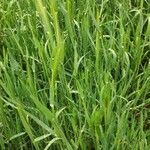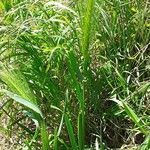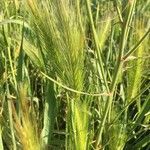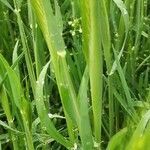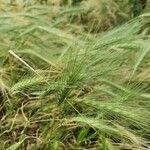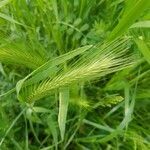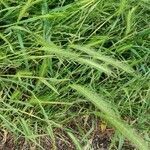Annual, erect. Culms 6–60 cm tall. Leaves with auricles falcate, 0.5 mm long; ligule 0.5–1 mm long, hyaline; blade 2–20 cm long, 2–8 mm wide, flat, pilose on both surfaces. Inflorescence 4–12 cm long; rachis shattering above spikelets. Lateral spikelets male or sterile; lower glume basally dilated, ciliate; upper glume bristle-like, scabrous on margins. Bisexual spikelet: lower glume subulate or oblong, 20–30 mm long, cartilaginous or indurate, ciliate, scabrous on midnerve and intercostal regions glabrous to scabrous; lemma lanceolate or elliptic, 7–14 mm long, acuminate, with awn 15–45 mm long, coriaceous, 5-nerved, scabrous on nerves with intercostal regions glabrous; palea infolded along midnerve, with nerves and intercostal regions glabrous to papillose; anthers 3, 0.7–1.6 mm long.
A tufted annual grass. It grows 15-30 cm high. The stems are smooth and slender. The leaves are flat and 20 cm long by 2-8 mm wide. The veins underneath the leaf are rough to touch. The flowers occur in a spike. They are clustered in a dense erect head. This is 3-10 cm long. It breaks up at maturity. It has long erect awns. The side 2 spikelets are not longer nor plumper than the central one. There are several subspecies.
Much like no. 6 [Hordeum leporinum Link]; floret of the central spikelet sessile or subsessile, the rachilla-joint not nearly as long as the pedicels of the lateral spikelets; lemmas of the lateral spikelets larger, 10–18 mm; 2n=14, 28, 42. Roadsides, ditch-banks, and waste places; native of Europe, intr. and well established in w. U.S., sporadic with us.
Annual, up to 0.5 m tall. Leaves linear, soft, with auricles; ligule an unfringed membrane. Inflorescence a 2-ranked dense false spike. Spikelets grouped and falling in threes, with the middle one fertile, green and purple; laterals long-awned, up to 50 mm long; glumes long-ciliate at base. Fertile spikelet 1-flowered.
Annual to 50 cm. Leaves linear, soft, auricled. Spikelets in a 2-ranked false spike, green and purple, long-awned, glumes of lateral spikelets long-ciliate.
